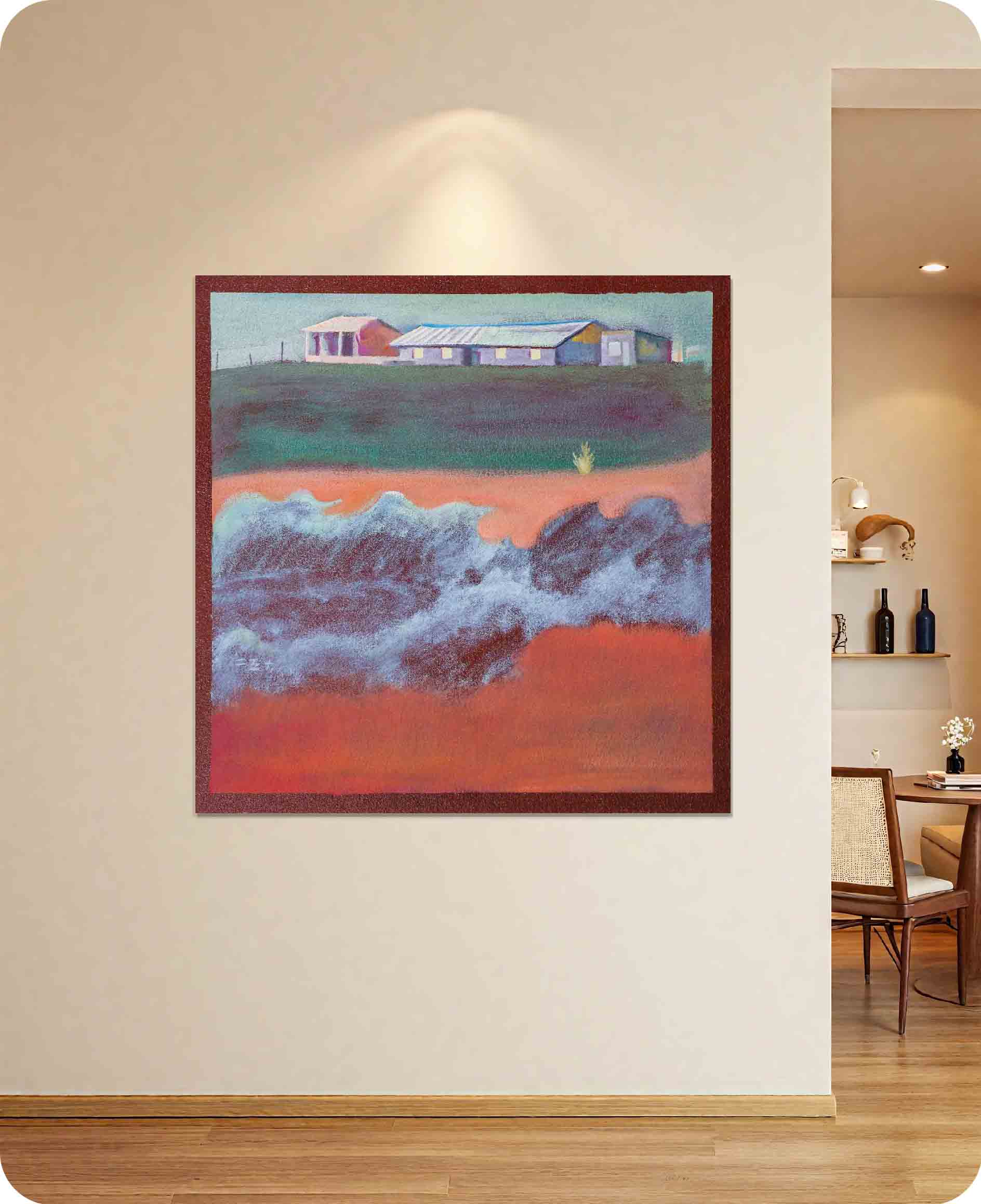The theme of this year's painting clearly states one - the makeup of desire. People's various desires are wrapped under various makeups. Desires are the intertwining of happiness and pain in life. Either straightforward or subtle, they will appear in makeup, forming a profound look of an era.
Inches: 15.7 x 15.7 in
Size without the frame: 40 x 40 cm
Country: China
Date: 2025
Materials: Oil paint on wood panel
Condition: well preserved
Creative themes and style | My works revolve around the creative concept of "The land of humanity, and the people upon it".The people in the painting are people in nature, and the lines, shapes, and colors are close to nature. The nature in the painting is nature in the eyes of humans, existing in interaction with humans.I don’t pursue a series of works with a fixed and continuous style. I hope that the style of the pictures will synchronize with the changes in my life and always remain oscillating. The performance of the work must be in sync with the development of one's own life in order to be Sincere and powerful.Ideas are later.
An Interview with Artist Philo by Artphiloso Gallery
If you would like to collect this artwork or know more about the artist, please contact us.


Form and Architectural Presence
The houses in this painting avoid meticulous realism, appearing instead as simplified geometric volumes. Their softened edges, blurred as if in the afterglow of intense sunlight, create a sense of calm that contrasts with the lonely starkness of Edward Hopper’s architecture. Though the perspective is not mathematically precise, the staggered placement of the structures across the slope builds a convincing sense of spatial depth. This reduction of form recalls Claude Monet’s distillation of natural motifs, though here the treatment feels more inward and subjective.
Layered Composition
The composition unfolds in horizontal strata: a deep green slope, an orange-red stretch of beach, and the rolling blue of waves. These bands act like stacked fields of color, rejecting conventional depth cues and moving closer to the flattened spatial logic of Color Field painting. Within this structure, each element maintains its autonomy while contributing to an interrelated whole. The static solidity of the houses is set in counterpoint to the restless movement of the sea, a tension that evokes the dreamlike juxtapositions often seen in Marc Chagall’s imagery.
Color as Emotional Projection
Color emerges as the most striking feature of the work. The bold interplay of green, orange, and blue does not attempt naturalistic accuracy; instead, it channels subjective emotion. The orange sand conveys scorching heat, the blue waves suggest a longed-for coolness, and the green slope hints at enduring vitality. This approach echoes Paul Gauguin’s use of color in Tahiti, where chromatic exaggeration was a way to capture not literal appearance, but the artist’s inner response to nature.
Brushwork and Atmosphere
The brushwork is restrained and understated, with colors layered and gently blended. There are no harsh strokes; instead, the paint appears to seep gradually into the surface, creating a soft diffusion of light and emotion. This technique recalls the intimate delicacy of Édouard Vuillard’s interiors, where subdued mark-making allows the work’s emotional charge to emerge through subtlety rather than overt drama.
Content and Thematic Depth
At its core, this painting presents a meeting point of human and natural presence. The houses mark habitation and culture, while the waves embody nature’s perpetual rhythm. Their convergence under the burning sun becomes a meditation on coexistence: humanity’s traces stand fragile yet persistent against the vast and enduring cycles of the natural world. The mood is both serene and contemplative, carrying undertones of melancholy for passing time, awe for natural power, and recognition of human resilience amid insignificance. In this way, the painting resonates with the quiet philosophical depth of Camille Corot’s landscapes, where serenity and reflection intertwine.
Edward Hopper, Landscape with Two Red Roofs
Like this painting, Hopper juxtaposes architecture with surrounding environment. Hopper’s treatment emphasizes isolation and detachment, while this work conveys warm intensity and emotional presence. Both, however, use simplified forms to shape atmosphere.
Claude Monet, Haystacks
Monet’s series demonstrates how color transforms perception under changing light. Similarly, this painting fixes a moment under the blazing sun through subjective chromatic choices. Both works employ lyrical color to construct emotional atmosphere rather than mere depiction.
The house, primarily in grays, blues, and light purples, features minimal detail and shows no human activity. This creates a serene, even isolated, atmosphere. It stands in stark emotional contrast to the turbulent waves below.
The waves use a cool-toned palette of blues and purples. Their layered texture is achieved through delicate dry-brush techniques. This creates a high-saturation contrast with the vibrant orange-red zone below, resulting in an effect that is both abstract and rich with emotional suggestion.
The cooler, calmer tones of the upper section clash dramatically with the fiery reds and oranges below. This intentional collision of warm and cool colors creates strong visual tension. It evokes a sense of dialogue between natural forces and the human dwelling.
Positioned between the house and the waves, the green zone acts like a transitional buffer. It provides a color bridge between the cool and warm areas, and also balances the emotional weight of the stillness of the structure against the movement of the sea.
Progressing from bottom to top – the red-orange ground, the blue-purple waves, the green buffer zone, and the houses/structures – the painting establishes four distinct visual layers. Each layer could stand alone as its own scene, yet together they weave a metaphorical narrative about the relationship between nature and humankind.
A: Click here to view ARTPHILOSO's Guide for Collectors.
More paintings from this series:
End of the Blazing Sun 3 End of the Blazing Sun 4
End of the Blazing Sun 5 End of the Blazing Sun 6
End of the Blazing Sun 7 End of the Blazing Sun 8
End of the Blazing Sun 9 End of the Blazing Sun 10
